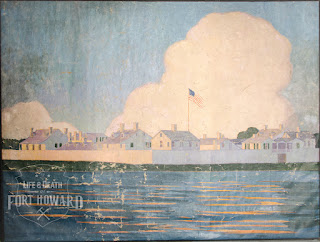The Murder of Lt. Foster and His Frock Coat
In the Generations Gallery, you can get lost in all the
stories and artifacts between the mastodon and the 1908 Holsman Car. But the
stories untold in the exhibit are even more remarkable. There is one storied
blue military coat tucked in a drawer in the Exposed Collections wall. The
story of the coat owner's fate is captivating.

Painting of Fort Howard from 1889 by B. Ostertac
189 years ago, Lt. Amos Foster was shot and killed by one of
his own soldiers, Private Patrick Doyle.
In February 1832, Doyle was detained in the guardhouse for being drunk
and disorderly. Alcohol consumption was
a real problem at Fort Howard, especially since part of the soldier’s rations
included two gills of whiskey or rum (the equivalent of four shots today). After a few days, on February 7, 1832, Doyle
persuaded a guard to escort him to Lt. Foster’s quarters to talk to him. After harsh words and a scuffle, Doyle stole
the guard’s musket and killed Lt. Foster.
Doyle was immediately arrested.
He was tried and sentenced to death in July of 1832. It is said Doyle was hanged outside the
stockade wall of the fort for all to see.
 |
| Entry point of the bullet that killed Lt. Foster |
My big question when I started to look at the coat more
closely was how do we know? How do we
know what happened and the supposed words exchanged between Lt. Foster and
Doyle? How do we know this was Lt.
Foster’s coat? After I started pulling
at this thread I found there is far more to this story than has been told. After digging through historical documents,
different stories of the incident were revealed. Interesting tales of Doyle’s time while he was
incarcerated and even a ghostly haunting of the officer’s quarters are mentioned
in people’s memoirs.
Beyond historical documents, the coat itself can tell you
another part of the story. It reveals
Lt. Foster’s role in society while he wore it (a lieutenant in the U.S. Army
Infantry based on the coat construction and rank insignia). It can also share insight to his early
demise. We can clearly see where the
bullet entered and exited. We can see
loss of wool from blood staining. It is
also probable the surgeon at the time, Dr. Clement Finely, tried to get at the
wounds quickly. The bottom 7 buttons
appear to have been cut off, probably because they were buttoned at the time of
the murder. 
The coat Lt. Foster was wearing when he was murdered on February 7, 1832
In the old exhibit “On the Edge of the Inland Sea” the real
coat was not on exhibit, instead there was a pristine replica. Why would we not put the real thing out? The coat has been through a lot! It has been through 19th century Wisconsin
winters, a gunshot, blood stains, and several years in an attic in Texas. When we were in the initial stages of
redesigning the gallery, we knew we wanted to display the real thing. We were able to do this safely in a drawer in
the Exposed Collections wall of the Generations Gallery. By being in a drawer it’s protected from
constant light exposure and damage that can happen when historic textiles are
exhibited on mannequins for a long period of time.
There is so much more we can and will share about this
special artifact, but nothing beats seeing the real thing.
Lisa Kain
Curator



Comments
Post a Comment